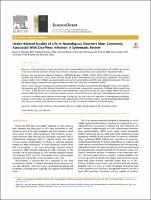| dc.creator | Miranda, Rafael N. | |
| dc.creator | Ximenes, Raphael | |
| dc.creator | Gebretekle, Gebremedhin B. | |
| dc.creator | Bielecki, Joanna M. | |
| dc.creator | Sander, Beate | |
| dc.date.accessioned | 2023-08-24T13:23:17Z | |
| dc.date.available | 2023-08-24T13:23:17Z | |
| dc.date.issued | 2020-07-01 | |
| dc.identifier.citation | Miranda, R.N., Ximenes, R., Gebretekle, G. B., Bielecki, J. M. y Sander, B. (2020). Health-related quality of life in neurological disorders most commonly associated with zika-virus infection: a systematic review. Value Health. Paises Bajos : Elsevier, 23(7), pp. 969-976. | es_AR |
| dc.identifier.other | 26024 | |
| dc.identifier.other | CCPI-CNyE-A-133 | |
| dc.identifier.uri | https://hdl.handle.net/20.500.12219/5077 | |
| dc.description | Fil: Miranda, Rafael N. University Health Network; Canadá. | es_AR |
| dc.description | Fil: Ximenes, Raphael. University Health Network; Canadá. | |
| dc.description | Fil: Gebretekle, Gebremedhin B. University Health Network; Canadá. | |
| dc.description | Fil: Bielecki, Joanna M. University Health Network; Canadá. | |
| dc.description | Fil: Sander, Beate. University Health Network; Canadá. | |
| dc.description.abstract | Objectives: In this systematic review, we synthesize the current evidence on health-related quality of life (HRQoL) for the two
of the most relevant outcomes of Zika virus infection in humans, microcephaly and Guillain-Barré Syndrome (GBS).
Methods: We searched the following databases: MEDLINE, Embase, CINAHL, LILACS, WHO’s ICTRP clinical trials registries
database and PROSPERO. Search terms included quality of life, microcephaly, and Guillain-Barré Syndrome. We included
primary studies where HRQoL was quantitatively assessed for microcephaly and GBS using validated instruments. We used
the Joanna Briggs Institute Critical Appraisal Tools to assess the risk of bias of individual studies.
Results: From a total of 1,657 abstracts screened and 66 full texts reviewed, 21 studies met the eligibility criteria; one study for
microcephaly and 20 for GBS. Adjusted disutilities for microcephaly compared to a normative childhood utility ranged from
20.745 to 20.820. For GBS, time traded-off the expected lifetime ranged from 16 days to 3 years. HRQoL follows the clinical
course of GBS, with lower scores in the first months, recovery within the first year post onset, and stabilization after one year.
Conclusions: Included studies reported a wide range of HRQoL for GBS, due in part to a high level of heterogeneity in methods,
inclusion criteria, follow-up and reporting of results. Opportunities exist for primary studies assessing the longitudinal HRQoL
over the entire course of the diseases to inform clinical practice, economic evaluations and health policy. | es_AR |
| dc.format | application/pdf | |
| dc.format.extent | 1.1 MB | |
| dc.language.iso | eng | es_AR |
| dc.publisher | Elsevier | es_AR |
| dc.relation | info:eu-repo/semantics/altIdentifier/urn/https://www.sciencedirect.com/science/article/pii/S1098301520301807 | |
| dc.relation | info:eu-repo/semantics/altIdentifier/urn/https://www.valueinhealthjournal.com/article/S1098-3015(20)30180-7/fulltext?_returnURL=https%3A%2F%2Flinkinghub.elsevier.com%2Fretrieve%2Fpii%2FS1098301520301807%3Fshowall%3Dtrue | |
| dc.rights | info:eu-repo/semantics/openAccess | |
| dc.subject | Guillain | es_AR |
| dc.subject | Barré syndrome | es_AR |
| dc.subject | Microcephaly | es_AR |
| dc.subject | Zika virus | es_AR |
| dc.subject | Health-related quality of life | es_AR |
| dc.subject | Systematic review | es_AR |
| dc.title | Health-related quality of life in neurological disorders most commonly associated with zika-virus infection : a systematic review | es_AR |
| dc.type | info:eu-repo/semantics/article | es_AR |
| dc.type | info:ar-repo/semantics/artículo | |
| dc.type | info:eu-repo/semantics/publishedVersion | |



